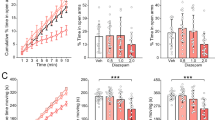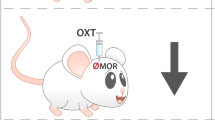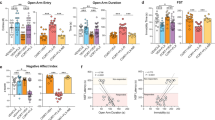Abstract
Several neurokinin NK1 receptor antagonists currently being developed for anxiety and depression have reduced affinity for the rat and mouse NK1 receptor compared with human. Consequently, it has proven difficult to test these agents in traditional rat and mouse models of anxiety and depression. This issue has been overcome, in part, by using non-traditional lab species such as the guinea pig and gerbil, which have NK1 receptors closer in homology to human NK1 receptors. However, there are very few reports describing the behavior of gerbils in traditional models of anxiety. The aim of the present study was to determine if the elevated plus-maze, a commonly used anxiety model, could be adapted for the gerbil. Using a specially-designed elevated plus-maze, gerbils exhibited an ‘anxious’ behavioral profile similar to that observed in rats and mice, i.e., reduced entries into, and time spent exploring, an open, aversive arm. The anxiolytic drugs diazepam (0.03–3 mg/kg i.p.), chlordiazepoxide (0.3–10 mg/kg i.p.), and buspirone (0.3–30 mg/kg s.c.) increased open arm exploration and produced anxiolytic-like effects on risk-assessment behaviors (reduced stretch-attend postures and increased head dips). Of particular interest, the antidepressant drugs imipramine (1–30 mg/kg p.o.), fluoxetine (1–30 mg/kg, p.o.) and paroxetine (0.3–10 mg/kg p.o.) each produced some acute anxiolytic-like activity, without affecting locomotor activity. The antipsychotic, haloperidol, and the psychostimulant, amphetamine, did not produce any anxiolytic-like effects (1–10 mg/kg s.c). The anxiogenic β-carboline, FG-7142, reduced time spent in the open arm and head dips, and increased stretch-attend postures (1–30 mg/kg, i.p.). These studies have demonstrated that gerbils exhibit an anxiety–like profile on an elevated plus-maze, and that the gerbil elevated plus-maze may have predictive validity for anxiolytics, and antidepressants with potential anxiolytic-like effects.
Similar content being viewed by others
Log in or create a free account to read this content
Gain free access to this article, as well as selected content from this journal and more on nature.com
or
References
Arch JR, Wilson S . (1996): Prospects for beta 3-adrenoceptor agonists in the treatment of obesity and diabetes. Int J Obes Relat Metab Disord 20: 191–199
Ballard TM, Sanger S, Higgins GA . (2001): Inhibition of shock-induced foot tapping behaviour in the gerbil by a tachykinin NK(1) receptor antagonist. Eur J Pharmacol 412: 255–264
Beresford IJ, Birch PJ, Hagan RM, Ireland SJ . (1991): Investigation into species variants in tachykinin NK1 receptors by use of the non-peptide antagonist, CP-96,345. Br J Pharmacol 104: 292–293
Blanchard RJ, Blanchard DC, Weiss SM, Meyer S . (1990): The effects of ethanol and diazepam on reactions to predatory odors. Pharmacol Biochem Behav 35: 775–780
Bristow LJ, Young L . (1994): Chromodacryorrhea and repetitive hind paw tapping: models of peripheral and central tachykinin NK1 receptor activation in gerbils. Eur J Pharmacol 253: 245–252
Bruinvels AT, Lery H, Nozulak J, Palacios JM, Hoyer D . (1992): 5–HT1D binding sites in various species: similar pharmacological profile in dog, monkey, calf, guinea-pig and human brain membranes. Naunyn Schmiedebergs Arch Pharmacol 346: 243–248
Cao BJ, Rodgers RJ . (1997): Comparative behavioural profiles of buspirone and its metabolite 1-(2-pyrimidinyl)-piperazine (1-PP) in the murine elevated plus-maze. Neuropharmacology 36: 1089–1097
Cheeta S, Tucci S, Sandhu J, Williams AR, Rupniak NMJ, File SE . (2001): Anxiolytic actions of the Substance P (NK1) receptor antagonist L-760,735 and the 5-HT1A agonist, 8-OH-DPAT in the social interaction test in gerbils. Brain Res 915: 170–175
Clark MM, Galef BG Jr . (1981): Environmental influence on development, behavior, and endocrine morphology of gerbils. Physiol Behav 27: 761–765
Clark MM, Galef BG Jr . (1982): Environmental effects on the ontogeny of exploratory and escape behaviors of Mongolian gerbils. Devel Psychobiol 15: 121–129
Cole BJ, Hillmann M, Seidelmann D, Klewer M, Jones GH . (1995): Effects of benzodiazepine receptor partial inverse agonists in the elevated plus maze test of anxiety in the rat. Psychopharmacology (Berl) 121: 118–126
Cole JC, Rodgers RJ . (1994): Ethological evaluation of the effects of acute and chronic buspirone treatment in the murine elevated plus-maze test: comparison with haloperidol. Psychopharmacology (Berl) 114: 288–296
Collinson N, Dawson GR . (1997): On the elevated plus-maze the anxiolytic-like effects of the 5-HT(1A) agonist, 8-OH-DPAT, but not the anxiogenic-like effects of the 5-HT(1A) partial agonist, buspirone, are blocked by the 5–HT1A antagonist, WAY 100635. Psychopharmacology (Berl) 132: 35–43
Creese I, Iverson SD . (1973): Blockage of amphetamine induced motor stimulation and stereotypy in the adult rat following neonatal treatment with 6-hydroxydopamine. Brain Res 55: 369–382
Cruz AP, Frei F, Graeff FG . (1994): Ethopharmacological analysis of rat behavior on the elevated plus-maze. Pharmacol Biochem Behav 49: 171–176
Cutler MG . (1990): Behavioral effects in gerbils of the 5–HT3 receptor antagonists, BRL 43694 and ICS 205–930, under circumstances of high and low light intensity. Neuropharmacology 29: 515–520
Cutler MG, Piper DC . (1990): Chronic administration of the 5–HT3 receptor antagonist BRL 43694; effects on reflex epilepsy and social behaviour of the Mongolian gerbil. Psychopharmacology (Berl) 101: 244–249
Dalvi A, Rodgers RJ . (1999): Behavioral effects of diazepam in the murine plus-maze: flumazenil antagonism of enhanced head dipping but not the disinhibition of open-arm avoidance. Pharmacol Biochem Behav 62: 727–734
Ellard CG, Stewart DJ, Donaghy S, Vanderwolf CH . (1990): Behavioral effects of neocortical and cingulate lesions in the Mongolian gerbil. Behav Brain Res 36: 41–51
Field KJ, Sibold AL . (1999): The Laboratory Hamster & Gerbil (Ed. M. Suckow) Boca Raton, FL, CRC Press
File SE . (2000): NKP608, an NK1 receptor antagonist, has an anxiolytic action in the social interaction test in rats. Psychopharmacology (Berl) 152: 105–109
File SE, Cheeta S, Akanezi C . (2001): Diazepam and nicotine increase social interaction in gerbils: a test for anxiolytic action. Brain Res 888: 311–313
Gitter BD, Waters DC, Bruns RF, Mason NR, Nixon JA, Howbert JJ . (1991): Species differences in affinities of non-peptide antagonists for substance P receptors. Eur J Pharmacol 197: 237–238
Glick SD . (1972): Changes in amphetamine sensitivity following frontal cortical damage in rats and mice. Eur J Pharmacol 20: 351–356
Graham EA, Turpin MP, Stubbs CM . (1993): Characterisation of the tachykinin-induced hindlimb thumping response in gerbils. Neuropeptides 4: 228
Griebel G, Moreau G-L, Jenck F, Martin JR, Misslin R . (1993): Some critical determinants of the behaviour of rats in the elevated plus-maze. Behav Proc 29: 37–48
Griebel G, Rodgers RJ, Perrault G, Sanger DJ . (1997): Risk assessment behaviour: evaluation of utility in the study of 5-HT-related drugs in the rat elevated plus-maze test. Pharmacol Biochem Behav 57: 817–827
Hascoet M, Bourin M, Colombel MC, Fiocco AJ, Baker GB . (2000): Anxiolytic-like effects of antidepressants after acute administration in a four-plate test in mice. Pharmacol Biochem Behav 65: 339–344
Hogg S . (1996): A review of the validity and variability of the elevated plus-maze as an animal model of anxiety. Pharmacol Biochem Behav 54: 21–30
Koks S, Beljajev S, Koovit I, Abramov U, Bourin M, Vasar E . (2001): 8-OH-DPAT, but not deramciclane, antagonizes the anxiogenic-like action of paroxetine in an elevated plus-maze. Psychopharmacology (Berl) 153: 365–372
Kramer MS, Cutler N, Feighner J, Shrivastava R, Carman J, Sramek JJ, Reines SA, Liu G, Snavely D, Wyatt-Knowles E, Hale JJ, Mills SG, MacCoss M, Swain CJ, Harrison T, Hill RG, Hefti F, Scolnick EM, Cascieri MA, Chicchi GG, Sadowski S, Williams AR, Hewson L, Smith D, Rupniak NMJ . (1998): Distinct mechanism for antidepressant activity by blockade of central substance P receptors. Science 281: 1640–1645
Kurt M, Arik AC, Celik S . (2000): The effects of sertraline and fluoxetine on anxiety in the elevated plus-maze test in mice. J Basic Clin Physiol Pharmacol 11: 173–180
Lapin IP . (1993): Anxiogenic effect of phenylethylamine and amphetamine in the elevated plus-maze in mice and its attenuation by ethanol. Pharmacol Biochem Behav 44: 241–243
Lee CC, Rodgers RR . (1991): Effects of buspirone on antinociceptive and behaviourial responses to the elevated plus-maze in mice. Behav Pharmacol 2: 491–496
Liggett SB . (1992): Functional properties of the rat and human beta 3-adrenergic receptors: differential agonist activation of recombinant receptors in Chinese hamster ovary cells. Mol Pharmacol 42: 634–637
Lightowler S, Kennett GA, Williamson IJ, Blackburn TP, Tulloch IF . (1994): Anxiolytic-like effect of paroxetine in a rat social interaction test. Pharmacol Biochem Behav 49: 281–285
Limberger N, Deicher R, Starke K . (1991): Species differences in presynaptic serotonin autoreceptors: mainly 5–HT1B but possibly in addition 5–HT1D in the rat, 5–HT1D in the rabbit and guinea-pig brain cortex. Naunyn Schmiedebergs Arch Pharmacol 343: 353–364
Lister RG . (1987): The use of a plus-maze to measure anxiety in the mouse. Psychopharmacology (Berl) 92: 180–185
Molewijk HE, Hartog K, van der Poel AM, Mos J, Olivier B . (1996): Reduction of guinea pig pup isolation calls by anxiolytic and antidepressant drugs. Psychopharmacology (Berl) 128: 31–38
Molewijk HE, van der Poel AM, Mos J, van der Heyden JA, Olivier B . (1995): Conditioned ultrasonic distress vocalizations in adult male rats as a behavioural paradigm for screening anti-panic drugs. Psychopharmacology (Berl) 117: 32–40
Moser PC . (1989): An evaluation of the elevated plus-maze test using the novel anxiolytic buspirone. Psychopharmacology (Berl) 99: 48–53
Nikolaus S, Huston JP, Hasenohrl RU . (1999): The neurokinin-1 receptor antagonist WIN51,708 attenuates the anxiolytic-like effects of ventralpallidal substance P injection. Neuroreport 10: 2293–2296
Papp M, Vassout A, Gentsch C . (2000): The NK1-receptor antagonist NKP608 has an antidepressant-like effect in the chronic mild stress model of depression in rats. Behav Brain Res 115: 19–23
Pellow S, Chopin P, File SE, Briley M . (1985): Validation of open:closed arm entries in an elevated plus-maze as a measure of anxiety in the rat. J Neurosci Methods 14: 149–167
Pellow S, File SE . (1986): Anxiolytic and anxiogenic drug effects on exploratory activity in an elevated plus-maze: a novel test of anxiety in the rat. Pharmacol Biochem Behav 24: 525–529
Podhorna J, Brown RE . (2000): Flibanserin has anxiolytic effects without locomotor side effects in the infant rat ultrasonic vocalization model of anxiety. Br J Pharmacol 130: 739–746
Rodgers RJ . (1997): Animal models of ‘anxiety’: where next? Behav Pharmacol 8: 477–504
Rodgers RJ, Cole JC, Aboualfa K, Stephenson LH . (1995): Ethopharmacological analysis of the effects of putative ‘anxiogenic’ agents in the mouse elevated plus-maze. Pharmacol Biochem Behav 52: 805–813
Rodgers RJ, Johnson NJ . (1995): Factor analysis of spatiotemporal and ethological measures in the murine elevated plus-maze test of anxiety. Pharmacol Biochem Behav 52: 297–303
Routtenberg A, Kramis RC . (1967): “Foot-stomping” in the gerbil: Rewarding brain stimulation, sexual behavior, and foot shock. Nature 214: 173–174
Rupniak NM, Williams AR . (1994): Differential inhibition of foot tapping and chromodacryorrhoea in gerbils by CNS penetrant and non-penetrant tachykinin NK1 receptor antagonists. Eur J Pharmacol 265: 179–183
Rupniak NMJ, Carlson EC, Harrison T, Oates B, Seward E, Owen S, de Felipe C, Hunt S, Wheeldon A . (2000): Pharmacological blockade or genetic deletion of substance P (NK1) receptors attenuates neonatal vocalisation in guinea pigs and mice. Neuropharmacology 39: 1413–1421
Santarelli L, Gobbi G, Debs PC, Sibille EL, Blier P, Hen R, Heath MJS . (2001): Genetic and pharmacological disruption of neurokinin 1 receptor function decreases anxiety-related behaviors and increases serotonin function. Proc Natl Acad Sci 98: 1912–1917
Saria A . (1999): The tachykinin NK1 receptor in the brain: pharmacology and putative functions. Eur J Pharmacol 375: 51–60
Schatzberg AF . (2000): New indications for antidepressants. J Clin Psychiatry 61(Suppl 11): 9–17
Schreiber R, Melon C, De Vry J . (1998): The role of 5-HT receptor subtypes in the anxiolytic effects of selective serotonin reuptake inhibitors in the rat ultrasonic vocalization test. Psychopharmacology (Berl) 135: 383–391
Silva MT, Alves CR, Santarem EM . (1999): Anxiogenic-like effect of acute and chronic fluoxetine on rats tested on the elevated plus-maze. Braz J Med Biol Res 32: 333–339
Silva RC, Brandao ML . (2000): Acute and chronic effects of gepirone and fluoxetine in rats tested in the elevated plus-maze: an ethological analysis. Pharmacol Biochem Behav 65: 209–216
Taylor KM, Snyder SH . (1970): Amphetamine: Differentiation by d- and l–isomers of behavior involving brain norepinephrine or dopamine. Science 168: 1487–1489
Teixeira RM, Santos AR, Ribeiro SJ, Calixto JB, Rae GA, De Lima TC . (1996): Effects of central administration of tachykinin receptor agonists and antagonists on plus-maze behavior in mice. Eur J Pharmacol 311: 7–14
Varty GB, Morgan CA, Cohen-Williams M, Coffin VL . (2000): Pharmacological validation of a novel gerbil elevated plus-maze: Effects of neurokinin NK1 receptor antagonists. Abstracts of the Society for Neuroscience 26: 659.12
Vassout A, Veenstra S, Hauser K, Ofner S, Brugger F, Schilling W, Gentsch C . (2000): NKP608: a selective NK-1 receptor antagonist with anxiolytic-like effects in the social interaction and social exploration test in rats. Regul Pept 96: 7–16
Zohar J, Westenberg HG . (2000): Anxiety disorders: a review of tricyclic antidepressants and selective serotonin reuptake inhibitors. Acta Psychiatr Scand (Suppl 403): 39–49
Acknowledgements
The authors would like to thank Drs. Lisa Gold and John Hunter for their helpful comments and Roland Parker for his excellent craftsmanship in constructing the gerbil elevated plus-maze.
Author information
Authors and Affiliations
Corresponding author
Rights and permissions
About this article
Cite this article
Varty, G., Morgan, C., Cohen-Williams, M. et al. The Gerbil Elevated Plus-Maze I: Behavioral Characterization and Pharmacological Validation. Neuropsychopharmacol 27, 357–370 (2002). https://doi.org/10.1016/S0893-133X(02)00312-3
Received:
Revised:
Accepted:
Published:
Issue date:
DOI: https://doi.org/10.1016/S0893-133X(02)00312-3
Keywords
This article is cited by
-
The zebrafish (Danio rerio) anxiety test battery: comparison of behavioral responses in the novel tank diving and light–dark tasks following exposure to anxiogenic and anxiolytic compounds
Psychopharmacology (2022)
-
The plus maze and scototaxis test are not valid behavioral assays for anxiety assessment in the South African clawed frog
Journal of Comparative Physiology A (2019)
-
The Acute Post-Traumatic Period in Rats Is Accompanied by an Anxiety State and a Decrease in the Proportion of REM Sleep
Neuroscience and Behavioral Physiology (2018)
-
An elevated plus-maze in mixed reality for studying human anxiety-related behavior
BMC Biology (2017)
-
Magnesium treatment palliates noise-induced behavioral deficits by normalizing DAergic and 5-HTergic metabolism in adult male rats
Metabolic Brain Disease (2016)



